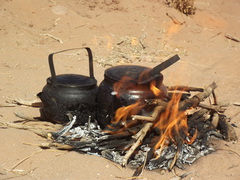Wadi Rum residents
Inhabited since the Neolithic period, Wadi Rum has been crossed for centuries by nomads who have left their traces in the form of rock inscriptions representing hunting scenes engraved on the rock.
These prints date from the VI-V century BC for the thamoudian markings and the VII century BC for the Nabatean inscriptions.
The Nabateans occupied the area before the Bedouin made this territory their own.

As ancient nomadic Arabs crossing the deserts of the Arabian Peninsula or Palestine regardless of frontiers, the Bedouins are now largely settled. They represent about 10% of the population of the Middle East.
Until the 1970s, the Bedouin of Wadi Rum lived in their goat hair tents raising goats, sheep and camels. Then they settled in the village of Wadi Rum located 5km from the Visitor Centre to enjoy a more comfortable life and especially to educate their children. However, they don’t miss an opportunity to return to their desert as soon as the school calendar allows them to. Only a few have kept the nomadic life-style of yesteryear.
If they remain farmers to provide milk, meat and ‘jameed’, a kind of yogurt, Bedouins are now engaged in tourism as their main source of income.
However, they perpetuate their traditions, especially the legendary “Bedouin hospitality”: tea ceremony, coffee with cardamom and warm welcoming.

Our tours
Hiking tours
- 1 day + 1 night
- 2 days + 1 night
- 3 days + 2 nights
- 4 days and more
Camel ride
- 1 day
- 1 day + 1 night
- 2 days + 1 night
Jeep tours
- From 1 day to several days
- Mixed with some camel ride
- Lawrence of Arabia road – 2 hours jeep
Climbing
- 1 day of climbing with ir without a camp
- Burdah arch, jebel Um Ad Dami, jebel Ash
A la carte
Compose your own program and contact Ali for pricing details by specifying the desired period and the number of visitors.